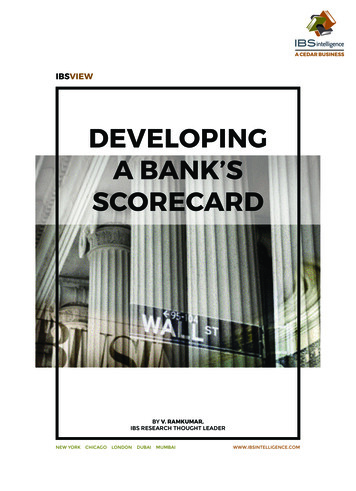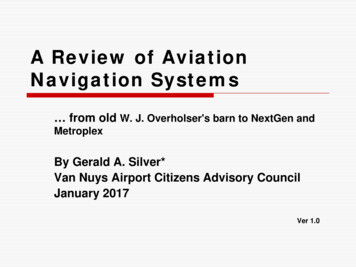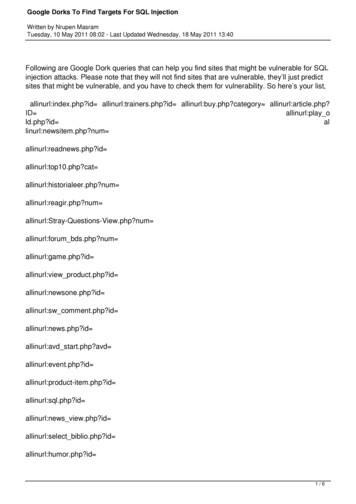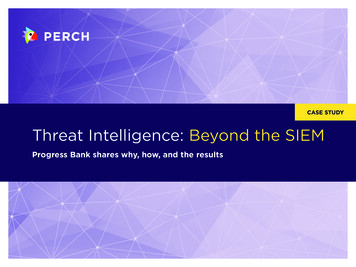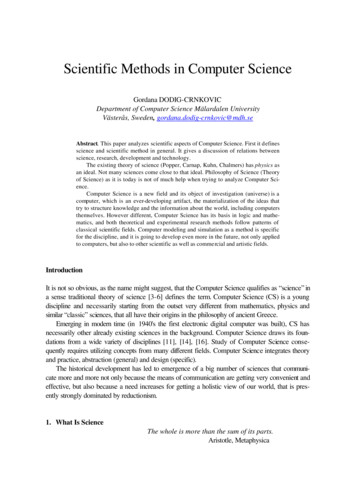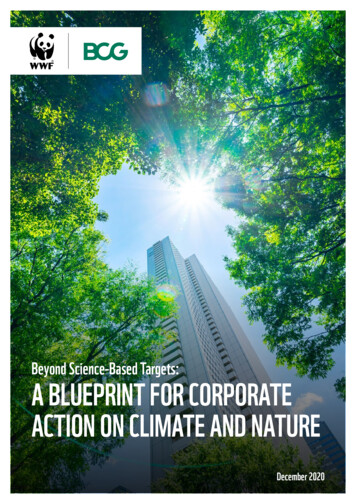
Transcription
Beyond Science-Based Targets:A BLUEPRINT FOR CORPORATEACTION ON CLIMATE AND NATUREDecember 2020
Primary Authors:WWF: Brad Schallert, Martha Stevenson, Chris Weber,Alex FarsanBCG: Jesper Nielsen, Paulina Ponce de León,Nicholas CollinsKey Contributors:WWF: Josefina Brana-Varela, Tim Juliani, Mark Griffiths,Christa Anderson, Lloyd Gamble, Evan Carlson,Mandy Jean WoodsBCG: Michel FrédeauAcknowledgements:WWF: Milan Kooijman, Johanna Myrman,Vanessa Perez CireraAbout WWFWorld Wide Fund for Nature (WWF) is an independentconservation organization, with over 30 million followersand a global network active in nearly 100 countries. Ourmission is to stop the degradation of the planet’s naturalenvironment and to build a future in which people live inharmony with nature, by conserving the world’s biologicaldiversity, ensuring that the use of renewable naturalresources is sustainable and promoting the reduction ofpollution and wasteful consumption.Find out more at panda.org/About Boston Consulting GroupBoston Consulting Group partners with leaders in businessand society to tackle their most important challenges andcapture their greatest opportunities. BCG was the pioneerin business strategy when it was founded in 1963. Today,we help clients with total transformation—inspiringcomplex change, enabling organizations to grow, buildingcompetitive advantage, and driving bottom-line impact.To succeed, organizations must blend digital and humancapabilities. Our diverse, global teams bring deep industryand functional expertise and a range of perspectives tospark change. BCG delivers solutions through leading-edgemanagement consulting along with technology and design,corporate and digital ventures—and business purpose. Wework in a uniquely collaborative model across the firm andthroughout all levels of the client organization, generatingresults that allow our clients to thrive.Find out more at bcg.comPublication date: December 2020Editor: Edward BakerDesign: 1tightship.co.zaCopyright 2020 World Wide Fund For Nature(formerly World Wildlife Fund), Gland, Switzerland andBoston Consulting Group. Any reproduction in full or inpart must mention the title and credit the above-mentionedpublishers as copyright owners.WWF International,Rue Mauverney 28,1196 Gland,SwitzerlandTel. 41 22 364 9111Boston Consulting Group200 Pier 4 BoulevardBoston,Massachusetts 02210United StatesTel. 1 617 973 1200For enquiries: CorporateClimateBlueprint@wwfint.orgCover photography: Voyata / Shutterstock.com Jacques Tarnero / Shutterstock.com
ContentsINTRODUCTION4CORE RATIONALE FOR A NEW BLUEPRINT5THE CORPORATE CLIMATE MITIGATION BLUEPRINT61. ACCOUNT AND DISCLOSE EMISSIONS2. REDUCE VALUE CHAIN EMISSIONS, IN LINE WITH ASCIENCE-BASED TARGET PATHWAY3. QUANTIFY A FINANCIAL COMMITMENT BY PRICINGREMAINING EMISSIONS4. INVEST THE FINANCIAL COMMITMENT FOR CLIMATEAND NATURE IMPACT Neil Ever Osborne / WWF-US88910MAXIMIZING VALUE ACROSS BUSINESS GOALS AND CO-BENEFITS12ADDITIONAL ELEMENTS OF CORPORATE CLIMATE STRATEGY13NEXT STEPS14ANNEX 1: ALIGNING WITH NET-ZERO TARGETS16ANNEX 2: CONSIDERATIONS FOR NATURE BASED SOLUTIONS17ANNEX 3: DIMENSIONS OF CARBON CREDIT QUALITY18
INTRODUCTIONEvery day, more companies large andsmall are proudly announcing theirvoluntary commitment to climateaction.Many are promising significant reductions in theirgreenhouse gas emissions, greater transparency into theircarbon footprints, plans to become net-zero by or before2050, and other climate goals. In parallel, there is increasinginterest in investing in nature-based solutions as a keypillar for climate ambition. This momentum is driven bycompanies’ determination to play their part in stoppingglobal climate change, as well as an understanding of thecompetitive advantages to be gained.Yet even companies with the best intentions face considerablehurdles when setting climate goals, crafting climatestrategies, and communicating them to the public. Becausethese voluntary initiatives are taking place in an emergingand fast-evolving field, companies often struggle to translatescientific consensus and knowledge (e.g., IPCC reports1), aswell as government commitments (e.g., Paris Agreement),into meaningful corporate climate strategies and actions.Inconsistent corporate claims about climate action (e.g.,net-zero, carbon positive, carbon negative, climate neutral,etc.) only add to the noise and confusion, — while raisingdoubts among stakeholders as to the credibility of individualcompanies’ climate strategies.2 The risk of being accused of‘greenwashing’ is ever-present, as is uncertainty as to whetherspecific corporate actions are truly advancing climate goals,nature goals, both, or neither.This paper introduces the Corporate ClimateMitigation Blueprint in hopes of cutting through thenoise and focusing on the actions that can underpina truly effective corporate strategy for mitigatingthe effects of climate change and protecting nature.This Blueprint is framed in the context of broader corporateclimate efforts, and thus also highlights three additionalcritical elements which must be done in parallel—advocatingfor climate policy such as carbon pricing and sector-specificincentives, collaborating with peers to achieve lasting climateprogress, and improving company and ecosystem resiliencein the face of global warming. Jean-Marie Hullot / FlickrCompanies that successfully integrate an effective climateresponse into their core business strategy will be able togenerate value. We’re seeing corporate leaders respond to theclimate challenge in a way that helps reduce costs, grow theirbusiness or capture price premiums, as well as maintain orextend their license to operate. Investors increasingly favorand value clear action on climate change – they recognizethat companies are building competitive advantage and longterm resilience. By implementing the actions recommendedin this Blueprint, companies will not only truly advance theirclimate and nature goals. They’ll become part of the solution,delivering value for all – investors and society – as we workto secure a net-zero world.We must, however, keep in mind that this Blueprint is onlya piece of corporate sustainability strategies, which mustencompass all environmental impacts from companiesand avenues for leadership on key elements such as water,biodiversity, and ecosystem conversion and degradation.Guidance as to how companies can complement their climatestrategies with broader nature strategies can be found inthe Science Based Targets Network’s Initial Guidance forBusiness and through other leading platforms in the mattersuch as the Business for Nature coalition, amongst others.1An element of confusion has been interpretation of pathways from IPCC’s Special Report on 1.5. Figure 2.5 from this report clearly reflects that all viable 1.5 Cpathways (across SSP 1, 2 & 5) require deep emissions reductions. They all also require negative emissions (i.e., removals), but not until the 2040 time frame.Often interpretation will jump to needing to start land removals now – as trees need time to grow – but time is also an important factor for fossil fuel emissions,as all of the pathways reflect that the earlier the fossil fuel emissions are reduced, the fewer removals will be needed later. It is important to look at the fullpicture of these results and what they will require.2Corporate climate claims and future climate commitments vary significantly between companies, both in terminology and meaning. Common examples includeCarbon Neutral, Climate Neutral, Net Zero, Climate Positive, Climate Negative, and 100% Green. Key variations behind these claims include: type of pollutantscovered (e.g., carbon only vs. Kyoto gases, vs. broader climate and/or nature impacts); extent of value chain coverage (e.g., scope 1 commitments vs. scope1-3 commitments); timeframe of emissions covered (e.g., annual emissions vs. lifetime company emissions); mitigation levers utilized (e.g., abatement only,abatement CO2 removal credits only, abatement any type of credit); and degree of climate/nature positivity (e.g., mitigating more than the company’sannual footprint, investing beyond mitigation and supporting other nature, biodiversity or social goals). These variations risk obscuring the true ambition ofcompanies climate strategies, and making it difficult to track progress against goals.BEYOND SCIENCE-BASED TARGETS: A BLUEPRINT FOR CORPORATE ACTION ON CLIMATE AND NATURE
CORE RATIONALE FOR ANEW BLUEPRINTA new model for corporate climate action is needed for a number of reasons,but they can be boiled down to one key meta-problem—a mismatch betweenthe current solution set available and the scale of the problems they aretrying to solve.Existing ‘Footprint-based’ approaches (e.g., carbonaccounting, life cycle assessment) are ‘attributional’ andbackward-looking. They focus on the question “what is mycompany’s responsibility for GHG emissions in the previousyear?” This reductionist approach has been—and continuesto be—a critical component of corporate accountability. Itis the basis for today’s leading corporate climate mitigationstandard — the Science Based Targets Initiative (SBTi) — butit is only one component of what could be a more holisticsolution for corporate climate strategies today, where thefocus is also about looking forward. In short, the goal postshave moved; companies are no longer being asked about howthey plan to take responsibility for last year’s emissions alone,but also their long-term transitions to becoming net-zerobusinesses, their contribution to securing a net-zero economywrit large, and the appropriate role for nature-basedsolutions both inside and outside of their value chains.Another characteristic of footprint-based approaches is afocus on the singular measure of CO2 equivalents. However,companies rarely report performance based solely onprofitability; to maximize shareholder value, they mustmanage a variety of metrics including nonfinancial ones,and what they prioritize will vary by stage of growth andcontext. We need similar variety to evaluate and improvecorporate climate performance. The focus on companies’individual CO2e footprints has incentivized some corporateactions over others. From the desire to offset a company’sremaining emissions came a voluntary carbon market thatalso measures outcomes in CO2e units but that in some casesis not simultaneously able to deliver needed environmentaland social co-benefits and/or broader systemic change. It’sa reason for why the average quality of carbon credits in themarket must improve if it is to be a valid climate solution,and it’s also why companies need to be pursuing new waysof investing in climate and nature that reflect the scale oftransformation required to solve the challenges we face.3Redirecting businesses - and our economy – toward anet-zero and ‘nature positive’ future is the challenge of ourlifetime: we need 75 trillion in investments3 to deliveron the Paris Agreement, plus tremendous ingenuity andwillingness to change. The response must build on eachother’s efforts over a long-time horizon—with companiessimultaneously reducing their own operational emissions,decarbonizing their value chain, driving innovation tocreate future solutions for harder-to-abate emissions andengaging consciously and constructively on how to reachnature positive, including its biodiversity and societal values.Leading companies are already looking to invest in climatestrategies that go beyond their value chains.Each of these changes—leaders going beyond value chainboundaries, forward-looking and longer time horizons, andthe need for scaled finance—begs for a new model. A new wayfor companies to move from “I” to “we”, helping to achievethe kind of scale that science tells us is needed to achievesystem transitions in land & ecosystems, energy, urban &infrastructure, and industrial systems. A new way to buildbig-picture innovation for tomorrow’s climate solutionsdirectly into corporate climate strategies. A new way togenerate and capture value, while benefiting society and theplanet.The Corporate Climate Mitigation Blueprint discussed in thenext section proposes innovative solutions to solve the keychallenges companies are struggling with (outlined above)while ensuring robust credibility through a hierarchical setof actions that ensure companies do their part to rapidlydecarbonize and build scaled solutions within or outsidetheir value chain. The approach builds on existing practice—ensuring a critical use case for current tools like SBTi targets—but also goes beyond to add new tools and approaches,meeting the new needs of ambitious corporate leadership andscience-based system transformation.The Economic Case for Combating Climate Change, BCG Report, 20185
Jason Houston / WWF-USTHE CORPORATE CLIMATEMITIGATION BLUEPRINTThe Corporate Climate Mitigation Blueprint is a tool configured forcompanies to craft an action plan for maximizing their climate impact. Itcan be used both by companies looking to create their first comprehensiveclimate strategy and by those hoping to upgrade their strategies to stay atopthe leaderboard.As shown in Figure A, the Blueprint builds on the principlesthat underpin “the mitigation hierarchy,” a concept widelyknown and used in the field of sustainability.We recommend that companies:(1) Account and disclose their emissions across the valuechain(2) Reduce value chain emissions emissions, in line withan ambitious science-based target pathway(3) Make a financial commitment that internalizes theexternal costs of any remaining GHGs, and disclose allassumptions, including the implicit carbon price.(4) Invest the financial commitment on a menu ofpotential high-impact climate and nature actions. Someof these actions might generate quantifiable emissionreductions or remove carbon from the atmosphere,while others might unlock the pipeline of future climatesolutions. These solutions could include nature-basedsolutions, new emissions capture technologies, andeven business innovation and transformation effortsthat can further society’s move toward a net-zeroeconomy.The following sections lay out each of the four components of the Corporate Climate Mitigation Blueprint in greater detail.BEYOND SCIENCE-BASED TARGETS: A BLUEPRINT FOR CORPORATE ACTION ON CLIMATE AND NATURE
Figure A: The Corporate Climate Mitigation Blueprint and additional critical elements of corporate climate strategyCorporate Climate Mitigation Blueprint1Account& disclose23Reduce value chainemissions, in linewith an ambitiousscience-based targetpathwayaQuantify financialcommitment bypricing remainingemissionsb4Invest the financial commitmentfor climate and nature impactFurther emissionsreductionsUnlockingclimate solutionsQuality carboncredits/mitigationoutcomescLandscape financedClimate innovationeGHG reductionGHG removalAlongside and throughout .Influence climate policy inown sector and beyondCollaborate with value chain, peers,employees, and other key stakeholdersBuild resilience in achanging climatea. Emissions reductions must be compliant with the Paris Agreement to limit warming to 1.5ºC, or at most well-below 2ºC, above pre-industrial levels, such as by following a pathway providedby the Science-Based Targets initiative.b. Companies should disclose assumptions, including the internal carbon price used (even if implicit). Please refer to more detailed guidance on how to size financial commitments in the text.c. The term “mitigation outcome” refers to any type of ex-post climate mitigation, whether emissions reductions or the removal and sequestration of emissions from the atmosphere. Forreadability and simplicity the term “carbon credit” is instead used through the document; however, a carbon credit is a subset of the term mitigation outcome. Please refer to Annex 3regarding the dimensions of carbon credit quality.d. For example: Projects operating at a landscape or jurisdictional levele. For example: Technological and R&D innovation, efforts to advance climate business model innovationBEYOND SCIENCE-BASED TARGETS: A BLUEPRINT FOR CORPORATE ACTION ON CLIMATE AND NATURE7
1. ACCOUNT AND DISCLOSE EMISSIONSFull transparency is critical to companies’efforts to reduce their carbon footprint.Without an accurate and verified accounting of their GHGemissions across scopes 1, 2, and 3, companies cannotdetermine their baseline emissions, set reduction targets, orevaluate their progress.The first step is to use internationally recognized GHGaccounting standards, such as the GHG Protocol, tocreate a full accounting of their carbon footprint. Thenthey must transparently and publicly disclose their levelof emissions, mitigation targets, and the actions theyare taking now and in the future, through their regularcorporate reporting mechanisms or through organizationssuch as CDP. Companies should also disclose their climaterelated risks, opportunities, and strategies in line with therecommendations of the Task Force on Climate-relatedFinancial Disclosures (TCFD) and other best-in-classdisclosure frameworks and standards.42. REDUCE VALUE CHAIN EMISSIONS, IN LINEWITH A SCIENCE-BASED TARGET PATHWAYThe Paris Agreement requires that we limit global warmingto as close to 1.5 C as possible. If we are to meet this goal, wemust reduce GHG emissions by around 50% between nowand 2030, and reach net-zero globally by the second half ofthis century, according to the “Special Report on 1.5 C” fromthe UN’s Intergovernmental Panel on Climate Change.Companies should therefore begin by mitigating GHGemissions throughout their value chain (see Figure B). Asa first step, they should reduce their own emissions wherepossible, by avoiding emissions-producing activities, and byhalting carbon intensive operations, such as deforestationand land conversion. Then they should lower the carbonintensity of activities—their own and those across their valuechain—that cannot be avoided. This could include reducingthe use of fossil fuels, improving efficiency, purchasingrenewable energy, encouraging upstream suppliers to reducetheir own footprints, decreasing land degradation, andreducing the carbon impact of the products and servicesthey sell. To support these efforts, the Science Based Targetsinitiative (SBTi) provides clear guidance for differentcorporate sectors on how to develop and set GHG reductiontargets that are aligned with the latest climate science.Figure B. Reducing value chain emissions, in line with an ambitious science-based target pathway 52020203020402050Business as usual (BAU)baseline trajectory for emissions.Remaining emissionswhile delivering on SBTicommitmentSBTi 1.5 CPathway targetset by companyFor example, a company sets and delivers on their SBTi 1.5 C target. The gray bars reflect ‘remaining emissions’as the company works toward reductions.4These include SASB, CDSB, the Integrated Reporting Framework, and GRI.5While companies should ideally be setting 1.5 C-aligned targets under SBTi, the initiative also allows companies to set well-below 2 C targets.BEYOND SCIENCE-BASED TARGETS: A BLUEPRINT FOR CORPORATE ACTION ON CLIMATE AND NATURE
Meeting science-based emissions reduction targets is not justcritical from an environmental perspective. Doing so alsolowers the significant business and reputational risks faced bybusinesses as they make the transition to a net-zero businessenvironment. Every company is already facing considerableregulatory, policy, investor and consumer pressure to lowertheir carbon emissions, and the pressure will only increase inthe future. Companies that transform their business now arebuilding competitive advantage compared with those thatdelay the transition, something that investors increasinglyrecognize and reward.6As essential as this step is, for many companies it will likelybe the most difficult. It requires companies to undergo amajor transformation of their operations, their value chains,and their business models. Some companies may not beable to fully complete the transition until their political andregulatory context makes their ability to do so more likely,but most can do more to reduce their emissions today -- andin a way that brings savings and generates value. The need totake action is real, and the rewards are profound, both for theclimate and for companies’ future competitiveness.3. QUANTIFY A FINANCIAL COMMITMENTBY PRICING REMAINING EMISSIONSCompanies that reduce emissions across their value chainin line with the Paris Agreement goals will continue to emitGHGs. The third step in the Blueprint encourages companiesto quantify a financial commitment to address theirremaining value chain emissions, for example by setting aninternal carbon price, and disclose the assumptions used(see Figure C)Figure C. Quantify a financial commitment by pricing remaining emissions20205M tonsover 5 yrs203020402050Financial commitment2020-2025Remaining emissions (tons)Reference price (per ton)5Mx 20Total commitment 100MA sample financial commitment for five years of estimated remaining emissions at 20/ton. The company disclosesthe price per ton.The methods used to determine the size of the financialcommitment can vary. Sizing it using an explicit carbonprice is just one possible approach, but others could includecommitting a share of revenue or simply defining a specificinvestment amount. Regardless of the method, companiesshould disclose the implicit carbon price on which they arebasing their commitment, and how they arrived at that figure.6Some relevant benchmarks include: National trading schemes: 20 per ton of CO₂e (EUETS, World Bank)7 Companies’ internal prices (between 30 and 100per ton of CO₂e)8The Net-Zero Challenge: Fast-Forward to Decisive Climate Action. WEF and BCG report, January 20207Calculated as total financial commitment / total annual remaining emissions, in /TCO2e8Average calculated from company internal carbon price disclosures in the 2017 CDP report “putting a price on carbon” (high end of range used for companiesdisclosing multiple internal carbon prices)9
Modeled results showing prices compatible with theParis Agreement’s goals (between 100 and 400 perton of CO₂e by 2030)9 Estimated cost of landscape restoration (between 10and more than 100 per ton of CO₂e)10No matter how companies choose to determine the size oftheir financial commitment, the amount should be highenough to reflect the true social and environmental cost oftheir emissions.4. INVEST THE FINANCIAL COMMITMENTFOR CLIMATE AND NATURE IMPACTMaking a meaningful financial commitment enablescompanies to support a broad range of climate actions. Thechallenge is investing these resources in a way that maximizespositive impact (see Figure D). With this in mind, there arethree equally important mechanisms that companies shouldconsider dedicating their funding to:Figure D. Invest the financial commitment for climate and nature impact20302020A2040Allocation of investments20502020-2025A Further emissions reductions 25MB Unlocking climate solutions 60MC Quality carbon credits/mitigation outcomes 15MTotal commitment 100MCBThe company invests its financial commitment in three ways. 25 million toward further emissions reductions, 60million in unlocking climate solutions and 15 million toward quality carbon credits/mitigation outcomes.9IPCC’s SR15 report cites that meeting a 1.5 C scenario will require a carbon price in the 100- 400/ton range by 2030, see Figure 2.2610See Griscom et al (2017), categories ‘reforestation’, ‘peat restoration’, and ‘coastal restoration’BEYOND SCIENCE-BASED TARGETS: A BLUEPRINT FOR CORPORATE ACTION ON CLIMATE AND NATURE
A. Further emission reductions: If the carbon price usedto size a company’s financial commitment is higher than thecompany’s marginal abatement cost to continue reducingGHG emissions across its value chain, it should invest torealize these reductions. Examples of such investmentsinclude the use of renewable power, alternative fuels andmore sustainable raw materials.B. Unlocking climate solutions: As discussed above,financial commitments freed from the constraints ofquantifiable carbon impact can incentivize corporateinvestment in tomorrow’s transformative solutions.Landscape finance and investments in climate innovationoffer two critical avenues of action. Landscape finance: Nature-based solutionsimplemented at scale can holistically address all themajor drivers of deforestation, conversion and landdegradation. If done properly, these investments canyield considerable benefits for people, nature andthe climate. They need to be embedded in an overalllandscape, jurisdictional or national strategy, anchoredin robust baseline data, and owned and supported bydiverse constituencies who are confident about thebenefits the solutions can achieve. Targeted privatefinance in support of multi-stakeholder platforms thatcan promote constituency building, strategic planning,mapping, and project development, provides anessential foundation of credibility and sustainability forsubsequent investments. For further details on naturebased solutions, please see Annex 2. Climate innovation: Innovative technologies andnew business models are key to sustaining climatemitigation efforts over time, particularly in areas thatremain hard to mitigate. Potential areas for investmentinclude new efficiency technologies, material andenergy feedstocks, and direct air carbon capture, amongothers. Some of these innovations could be specific todecarbonization in individual business sectors, whileother climate innovations might be applicable morebroadly across the economy, such as CO2 removaltechnologies. Defining which investments should becategorized as “climate innovation” may be subjective.However, companies should be transparent and,where possible, clarify how these investments will helpadvance the transition to a low-carbon economy.C. Quality carbon credits/mitigation outcomes:Finally, decoupling a financial commitment from a CO₂emetric means that companies can consider investing in highquality “mitigation outcomes”--emissions reductions or theremovals of emissions from the atmosphere. These mitigationoutcomes can come in different forms. The most commonand understood form is a carbon credit/offset. For the sakeof simplicity, this paper uses the term “carbon credits” whichare usually freely transferable assets. But companies can alsoengage in direct bilateral transactions to finance emissionsreductions and removals using standardized methodologiesand certified by third parties (as most carbon credits aretoday).Supporting high-quality projects that reduce or removeGHGs outside of a company’s value chain can be a key way toaddress remaining emissions. But quality matters, as not allcarbon credits are created equal.While companies might be tempted to design a portfolio ofcarbon credits that encompasses their target CO2e volumewhile minimizing costs, they need to ensure their investmentis channeled towards projects that deliver long-lasting,quality results, and have no adverse impacts. For example,recent research shows CO2 emission reductions fromvoluntary REDD projects in the Brazilian Amazon havelikely been overstated11. Low-quality12 credits often claim thesame CO₂e impact as high-quality credits, yet they may offerfewer emission reductions or even negatively impact peopleand nature. While, in general, the price of a carbon credit andits quality are not necessarily correlated, there is evidencethat prices of carbon credits from the land sector and manytechnology development projects are currently too low todeliver long-lasting, quality results. Using a CO₂e metric,by itself, provides little or no incentive to deliver anythingbeyond a specific volume of carbon credits that may or maynot deliver the intended mitigation results.In assessing the quality of credits, corporate carboncredit buyers should take into account six criteria: robustmeasurement of mitigation impact, avoiding double counting,addressing non-permanence, alignment with a transitionto net-zero, strong governance of the crediting process, andenvironmental and social co-benefits. For further detailson carbon credit quality, please see Annex 3 and the latestguidance document from WWF, Environmental DefenseFund and Oeko Institute.11 West, T. A. P. et al. (2020). Overstated carbon emission reductions from voluntary REDD projects in the Brazilian Amazon. Proceedings of theNational Academy of Sciences of the United States of America PNAS September 29, 2020 117 (39) 24188-24194. Available at: https://www.pnas.org/content/117/39/2418812 There are many dimensions of quality to assess carbon credits - more details can be found in WWF, Environmental Defense Fund and Oeko Institut guidance(in development)11
Days Edge Productions / WWF-USMAXIMIZING VALUE ACROSSBUSINESS GOALS ANDCO-BENEFITSWhen investing in climate solutions or financing carbon credits, companiesmay have a positive impact beyond climate by investing in projects thatgenerate broader benefits for nature and society.Some investments, for example, may deliver on specificdevelopment or economic opportunities, create competitiveadvantage, or enhance efforts to protect biodiversity. In thelong run, a more holistic approach to the climate crisis—onethat contributes to the well-being of nature and people,and that generates long-term business value—will be moreimpactful.The opposite can also be true. Tradeoffs are inevitable whendesigning solutions for a complex environmental system.Companies should step away from projects that generatelow-cost carbon credits by maximizing near-term carbonsequestration, such as monoculture tree planting, or standalone forest projects that don’t link to the broader landscape.Such projects typically fail to build environmental resilienceor integrate into the fabric of the landscape or society topromote long-lasting action. Following the criteria for NBSBEYOND SCIENCE-BASED TARGETS: A BL
About Boston Consulting Group Boston Consulting Group partners with leaders in business and society to tackle their most important challenges and capture their greatest opportunities. BCG was the pioneer in business strategy when it was founded in 1963. T
